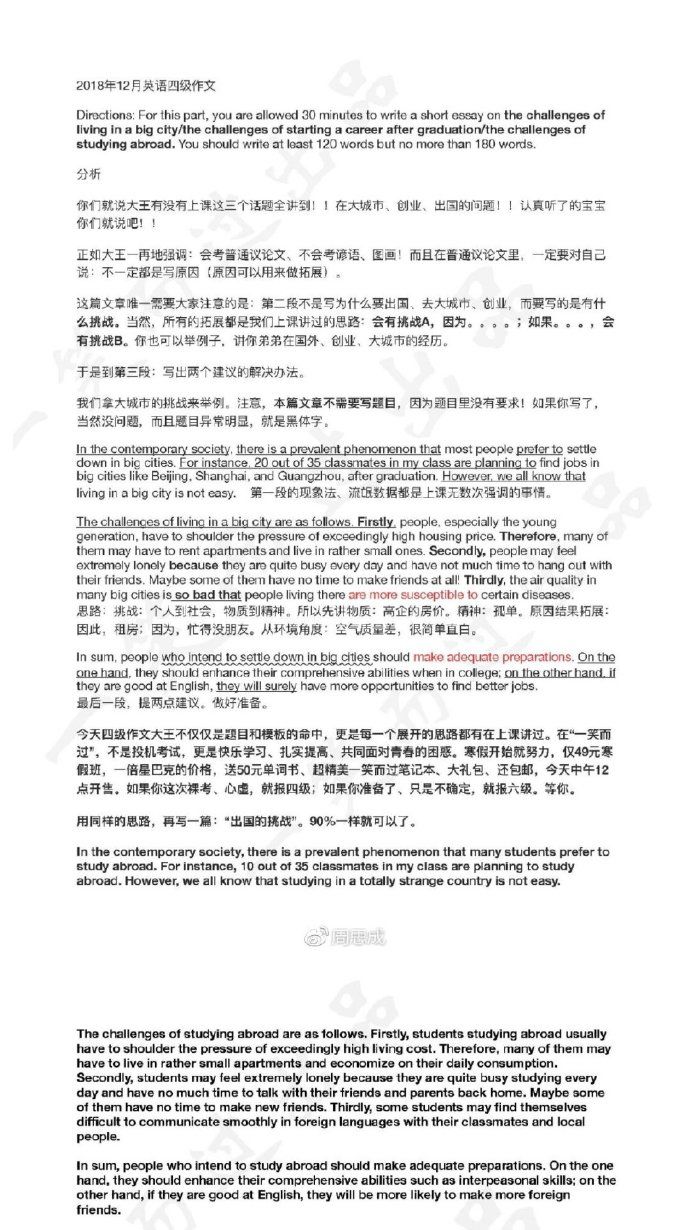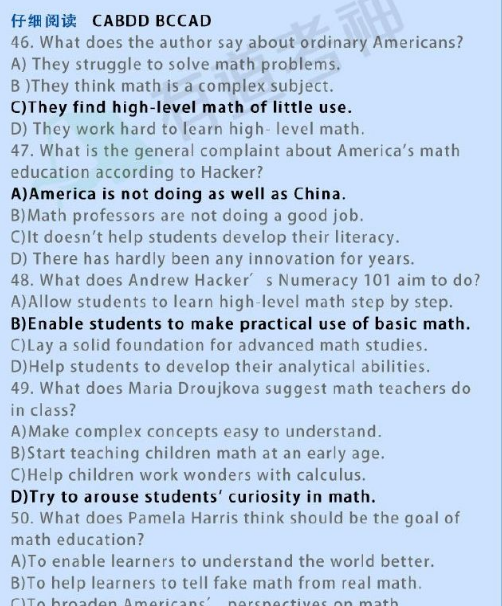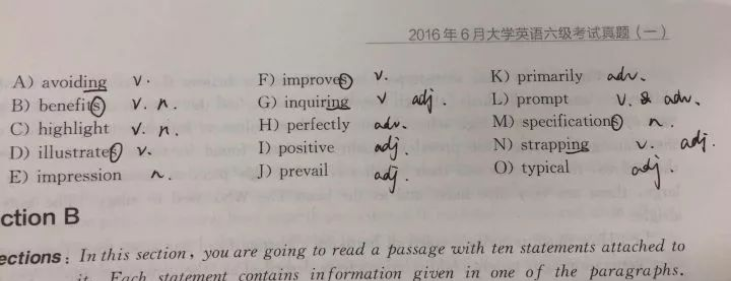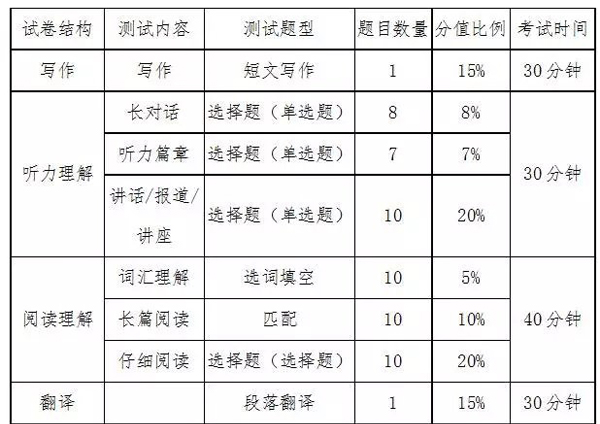新托福听力新增题型解析
|
引言: 《新托福听力——道是有变却无变》中从新托福听力的出题形式、内容以及出题原则着手分析,着重笔墨于新托福听力的内容及出题原则的无变性。本文将与读者从新托福听力的出题形式入手,一同再次剖析这"有变"背后的"无变"。 新托福听力新增题型之"Listen Again"是本次变革中最为显眼的听力测试形式。此测试形式之新颖独特处,乃览望国内外众多英语听力考察形式之未见所闻。 顾名思义,所谓"Listen Again"即在新托福听力考试的某篇文章结束后,其中某一题采取再次复听,然后根据所听来做推断既而回答题目的形式来考察考生。对新托福考试关注者会发现,早在新托福考试刚浮出水面时,世面上众多分析文章评论说:"新托福听力考试可以听两遍了"。我们下这样的定义不能说不对,但似为偏颇,至少会误导对新托福听力不甚了解的朋友会真的以为整个新托福听力考试可以重复放音听两遍了。这也怪不得关注新托福考试的先驱者。在未见其真面目时,仅依其官方网上透露的内容去揣摩难免会被ETS误导,即便是现在ETS在网上公布的新托福在线测试样题与9月份真正在北美正式投入使用的新托福考试题也是有差别的。在这里笔者稍做澄清:(1)新托福考试放音过程是一遍完成;(2)只有"Listen Again"这种新增题型可以再次复听文章中的某一部分,并根据再次回放的这部分回答特殊的问题。 看题: 下面我们看一篇新托福听力样题(此样题的考察问题全部为此种新增Listen Again 题型) (narrator) Listen to two student discussing a zoology course (man) Now, we can move on to discuss the next part of the chapter, the part of the chapter, the part on land tortoises (woman) Yes. Land tortoises are tortoises that don’t live in the water, although they may live near the water. They only come to the water to drink or bathe. (woman) Oh, look here in the book. Here’s a picture of one of the 40 kinds of land tortoises. (man) Land tortoises are the ones that live to such long ages, aren’t they? (woman) Yes, my favorite part of the chapter was the part that was about how long land tortoises can really live. (man) How old can they live to be? (woman) It’s not really known for sure. There are lots of traditional stories about tortoises that lived for hundreds of years. I do remember hearing, when I was young, about tortoises that were supposed to be one-to two hundred years old. (man) That couldn’t be…No way. (woman) Well, there’re a lot of stories, but there’s no accurate records, so it’s impossible to verify whether or not they’re true. (man) Well, how old is the oldest tortoise on record, do you know? (woman) In the chapter I just read, it said that the oldest tortoise whose age can be verified to some extent is the one known as Marion’s tortoise. (man) I read that Marion’s tortoise was 152 years old. (woman) Actually, I think the book said it was at least 152 years old. It was probably older. (man) So, they’re not really certain how old Marion’s tortoise really was when it died. What is truly known about Marion’s tortoise? (woman) It’s certain that a French explorer named de Fresne, Marion de Fresne captured an adult tortoise in 1766, and he transported the tortoise to the island of Mauritius in that same year. (man) Well, when did Marion’s tortoise die? Are there authentic records? (woman) Historians are satisfied with the authenticity of the records that show that Marion’s tortoise died in 1918. (man) How do they know it was the same tortoise? Could it have been a different tortoise that died there in 1918? (woman) Tortoises don’t occur naturally on Mauritius, so Marion’s tortoise was the only tortoise on the island of Mauritius. (man) And so this tortoise had been on the island of Mauritius for 152 years when it died. (woman) That’s right. Marion’s tortoise arrived in Mauritius in 1766 and died in 1918, so that would make it at least 152 years old. (man) But didn’t you say that the tortoise that was captured and brought to Mauritius by Marion de Fresne was an adult when it was captured? (woman) Yes. So Marion’s tortoise was known to have lived for 152 years on Mauritius. But because it was an adult when it was captured in 1766 and it’s unclear how old it was at that time, it could have been considerably older than 152 years when it died, maybe 180 years or more. Two hundred years old for this type of tortoise isn’t inconceivable. (man) So a tortoise living to the age of 200 may be possible, but there’re no verified records of such a tortoise. (woman) Exactly! (1)Why does the man say this: Now we can move on to discuss the next part of the chapter, the part on land tortoises (a) To indicate the next topic for discussion (b) To suggest a new location for the discussion (c) To state what has previously been said (d) To clarify why they are having the discussion (2)Listen again——Woman: There are lots of traditional stories about tortoises that lived for hundreds of years. I do remember hearing, when I was young, about tortoises that were supposed to be one-to two-hundred years old. Man: That couldn’t be…No way. How does the seem to feel when he says this: "That’s couldn’t be… No way" (a) Unhappy (b) Incredulous (c) Incapable (d) Disturbed (3) Listen again——(woman) In the chapter I just read, it said that the oldest tortoise whose age can be verified to some extent is the one known as Marion’s tortoise. (man) I read that Marion’s tortoise was 152 years old. (woman) Actually, I think the book said it was at least 152 years old. Why does the woman say this:" Actually,I think the book said it was at least 152 years old." (a) To contradict what was in the book (b) To indicate that she is not sure what is correct (c) To restate what the man said (d) To correct an error by the man (4)Listen again——(woman) Historians are satisfied with the authenticity of the records that show that Marion’s tortoise died in 1918. (man) How do they know it was the same tortoise? Could it have been a different tortoise that died there in 1918? What does the man mean when he says this: "How do they know it was the same tortoise? Could it have been a different tortoise that died there in 1918?" (a) What was said sounds plausible (b) Marion’s tortoise was not on the island of Mauritius (c) There may be an alternate explanation (d) There was only one tortoise on the island (5)Listen again——(woman) Yes. So Marion’s tortoise was known to have lived for 152 years on Mauritius. But because it was an adult when it was captured in 1766 and it’s unclear how old it was at that time, it could have been considerably older than 152 years when it died, maybe 180 years or more. Two hundred years old for this type of tortoise isn’t inconceivable. Which sentence best describes how the woman feels when she says this:"Two hundred years old for this type of tortoise isn’t inconceivable" (a) It is possible for a tortoise to live for 200 years (b) A tortoise could not possibly live to the age of 200 (c) No 200-year-old tortoise has ever been found (d) Many types of tortoises live to be very old (注)以上五道题目中带阴影部分皆是再次回放的内容。 (答案)(1)A (2)B (3)D (4)C (5)A 解析: 新增Listen Again题型属于测试考生Pragmatic understanding(recognize a Speaker’s attitude or degree of certainty; recognize a speaker’s function or purpose)即实际理解的能力。此类能力测试在整个新托福听力测试的比重占25%之多。也就是说,Listen Again题型处理好,新托福听力的总34道题目你将会解决至少6道题目。 那么到底Listen Again题型让我们考生实际理解什么?很简单,即要求考生去理解你再次听到的那段话中的: (1)Function(purpose): ask you to understand not just what the speaker said but why the speaker said it. For example, to determine that a speaker said sth in order to apologize, explain, clarify a point, change a topic, indicate a change of opinion, or suggest a new action.(上面样题第一题即是) (2)Stance (attitude) Ask you how the speaker seems to feel about a particular topic. For example, to determine if the speaker feels Positive or negative, happy or sad, impressed or unimpressed, or enthusiastic or bored about a particular Topic. Also ask about whether a speaker is doubtful or Certain about what he or she is saying.(上面样题后四道题目即是) 简单的说即对再次回放内容中讲话者讲此句话的目的或者态度进行推断。因此,考生解答此种问题时即便在全文放音过程中不知所云, 也要在Listen Again时,务必把握Listen Again内容——Listen carefully to what the speaker says in the part of the passage that is repeated and then draw a conclusion。 技巧: 其实根据上面样题所示,你也会发现:(1)勿须理解全文,只要理解Listen Again的内容你就可以对题目进行做答。(2)听再次回放内容时对讲话者的语气、语调应尤为关注。如第2题的那句That’s couldn’t Be…No way讲出来时语气格外激昂,可见讲话者的意图是针对第一人话语的一种不信,一种否定。(3)以往旧托福的解题技巧仍可应用,如第3题。以往在小对话中有这样一种叫做Actually的题型,即在答句开头听到Actually时,必为否定第一人观点的。第3题女方选手开头Actually,那么看哪个选项是否定男方的,D这个答案To correct the Error by the man即入选。 结论: 根据以上新增题型的解析,值得我们考生兴奋的是:此类题型应属送分题型,即便全文整体概念、信息模糊不清,但仍可只依靠再次回放的部分解决此种题型。再深入探求其本质,难道我们还能下新托福听力取消了原来小对话部分这样的定义吗?此种新增题型,不正是以往小对话所测试我们的基本所在吗(让我们去做推论)?只不过,现在的新增部分综合了95年8月前的单句题和95年8后的小对话题而已。现在的"Listen Again"题型——说它是单句题,它比单句题稍微显长显复杂;说它是小对话题,它比小对话题测试内容上要稍显更实际、更结合与学术。这不正是ETS此次托福考试改革关于听力部分的宗旨(Academic Listening Skills:The Listening section measures test takers’ ability to understand spoken English from North America and other English-speaking countries. In academic environments students need to listen to lectures and conversations. )吗 |








